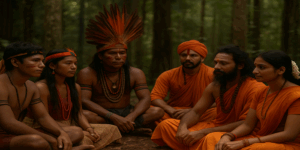Summary:
‘Aldous Huxley once said that an intellectual was someone who had found something more interesting than sex; in Indology, an intellectual need not make that choice at all.’
Wendy Doniger in ‘When the Lingam is Just a Cigar, Psychoanalysis and Hindu Sexual Fantasies”.
Wendy Doniger’s book “The Hindus, an Alternative History” (see the cover), published and distributed by Penguin has been a phenomenal sales success. Already (in February 2010), more than 600 libraries in North America have acquired a copy of the book, in less than one year since its publication. The Indian division of Penguin has brought out an Indian reprint as well. Doniger claims that her book is about Hindu women, low castes, dogs and horses. But these merely appear to be an excuse for her to indulge in bouts of lewd descriptions, imaginary rapes, violence, titillating sleaze, drugs, booze and the like – all of which is then superimposed on the Hindus and on their traditions. As usual, she kinks fairly straightforward narratives in Hindu scriptures to present her own pornographic versions.
Medieval India is not her forte at all, and Doniger is often seen reproducing (and even amplifying) the errors already present in her secondary and tertiary sources. The book is more than 600 pages long, and the number of errors average more than 1 per page. There are errors of chronology, of historical dates and sequence of events, geography, verifiable historical facts, proper names, translations of Sanskrit texts and so on. These errors are compounded by strained and agenda driven interpretations that whitewash medieval atrocities on Indians, perpetuate colonial and racist stereotypes about Hindus, attribute many positive developments within the Hindu society to impulses from Christianity or Islam and grossly distort historical evidence.
Some examples of derogatory statement & factual errors:
i. Page 40 ‘ ‘If the motto of Watergate was “Follow the money”, the motto of the history of Hinduism could well be “Follow the monkey” or, more often “Follow the horse”.”
Comment: Very derogatory and offensive. The motto of Hinduism is to follow the truth and unite with God.
ii. Page 112 – The author alleges that in Rigveda 10.62, it is implied that a woman may find her own brother in her bed!
Comment: The hymn has no such suggestion. It is offensive to suggest that the sacred text of Hindus has kinky sex in it.
iii. Page 128 – The book likens the Vedic devotee worshipping different Vedic deities to a lying and a philandering boyfriend cheating on his girlfriend(s).
Comment: This is offensive and ignores that fact that in the Rigveda, the gods are said to be all united, born of one another, and from the same source.
iv. Pages 468-469 -“The mosque, whose serene calligraphic and geometric contrasts with the perpetual motion of the figures depicted on the temple, makes a stand against the chaos of India, creating enforced vacuums that India cannot rush into with all its monkeys and peoples and colors and the smells of the bazaar”
Comment: It is simply unacceptable that a scholar can flippantly, pejoratively and derogatorily essentialize the Hindus as “monkeys and peoples, colors and smells.., and chaos’ in most insulting manner with the aspersion thrown at the entire Hindu culture and community all over the world. Such generalization has no place in serious scholarly work.
v. Page 571- It is alleged that in a hymn from Saint Kshetrayya’s poetry, ‘God rapes’ the women devotees.
Comment: The hymn merely presents devotion using spiritual metaphors and the hymns of the Saint seen collectively depict it as a passionate love affair between the God and the devotees. No rape is implied in this hymn at all.
vi. Page 450- It is claimed that Emperor Ala-ud-Din Khalji did not sack temples in Devagiri.
Comment: His contemporary Amir Khusro clearly mentions that the Emperor sacked numerous temples and raised mosques instead.
vii. Page 459 – King Ala-ud-din Husain of Bengal patronized Saint Chaitanya.
Comment: Saint Chaitanya never met the king, and left his kingdom to avoid persecution, as did his disciples. The king had destroyed Hindu temples in Orissa.
viii. Pages 537-538 – The Sikh teacher Guru Govind Singh was assassinated in 1708, while ‘attending Emperor Aurangzeb’.
Comment:‘ Emperor Aurangzeb died in 1707.’ Guru Gobind Singh was assassinated in 1708 during the reign of Aurangzeb’s successor, Emperor Bahadur Shah I. It is insulting to say that the Guru was ‘attending’ on the Emperor.
In her book, Hindu Deities are presented as lustful, Hindu Saints are falsely alleged by the author to have indulged in sexual orgies, or to have ‘taken actions against Muslims’, Hindu worshippers are compared to cheating boyfriends, ‘intoxication’ is a ‘central theme of the Vedas’ and Hindu scriptures are presented as a litany of tales of faithful women forsaken by their ungrateful husbands. One wonders if these caricatures of Hinduism really reflect the author’s own life rather than the culture and traditions of Hindus. Doniger claims to ‘love’ Hindus or their culture in her book, but this claim appears quite bizarre, perverse and frightening.
This chapter by chapter review below will give dozens of examples to illustrate the defects that abound in every section of her scandalous book. The list is of course not exhaustive and is not intended to be so. In her ‘Acknowledgments’ section, Doniger thanks some of her students for the help that they provided to her in writing some of the chapters. It does appear that they have failed their teacher. Or perhaps, she has failed them.
 Readers may click at the chapter title below to read my discussions on errors and distortions in that respective chapter. Permission is granted to reproduce these files (without alteration of their content) on other websites. If you have any comments or corrections, please write to me at vishalsagarwal@yahoo.com . If you need MSWord versions of these documents, please write to me with the reason for needing the same.
Readers may click at the chapter title below to read my discussions on errors and distortions in that respective chapter. Permission is granted to reproduce these files (without alteration of their content) on other websites. If you have any comments or corrections, please write to me at vishalsagarwal@yahoo.com . If you need MSWord versions of these documents, please write to me with the reason for needing the same.
by Vishal Agarwal
|
Critique� & Review of the book � Chapter by Chapter |
||
| Chapter # | Title | Page # (in the book) |
| N/A | Maps | |
| Preface | The Man or the Rabbit in the Moon | 1 |
| 1) | Introduction: Working with Available Light | 17 |
| 2) | Time and Space in India: 50 Million to 50,000 bce | 50 |
| 3) | Civilization in the Indus Valley: 50,000 to 1500 bce | 65 |
| 4) | Between the Ruins and the Text: 2000 to 1500 bce� | 85 |
| 5) | Humans, Animals, and Gods in the Rig Veda: 1500 to 1000 bce | 103 |
| 6) | Sacrifice in the Brahmans: 800 to 500 bce | 135 |
| 7) | Renunciation in the Upanishads: 600 to 200 bce | 164 |
| 8) | The Three (or is it Four?) Aims of Life in the Hindu Imaginary | 199 |
| 9) | Women and Ogresses in the Ramayana: 400 to 200 ce | 212 |
| 10) | Violence in the Mahabharata: 300 bce to 300 ce | 252 |
| 11) | Dharma in the Mahabharata: 300 bce to 300 ce | 277 |
| 12) | Escape Clauses in the Shastras: 100 bce to 400 ce | 304 |
| 13) | Bhakti in South India: 100 bce to 900 ce | 338 |
| 14) | Godesses and Gods in the Early Puranas: 300 to 600 ce | 370 |
| 15) | Sects and Sex in the Tantric Puranas and the Tantras: 600 to 900 ce | 406 |
| 16) | Fusion and Rivalry Under the Delhi Sultanate: 650 to 1500 ce | 445 |
| 17) | Avatar and Accidental Grace in the Later Puranas: 800 to 1500 ce | 473 |
| 18) | Philosophical Feuds in South India and Kashmir: 800 to 1300 ce | 503 |
| 19) | Dialogue and Tolerance Under the Mughals: 1500 to 1700 ce | 527 |
| 20) | Hinduism Under the Mughals: 1500 to 1700 ce | 551 |
| 21) | Caste, Class and Conversion Under the British Raj: 1600 to 1900 ce | 574 |
| 22) | Suttee and Reform in the Twight of the Raj: 1800 to 1947 ce | 610 |
| 23) | Hinduism in America: 1900- | 636 |
| 24) | The Past in the Present: 1950- | 654 |
| 25) | In conclusion, or, the Abuse of History | 687 |
| Bibliography | ||






























2 Comments